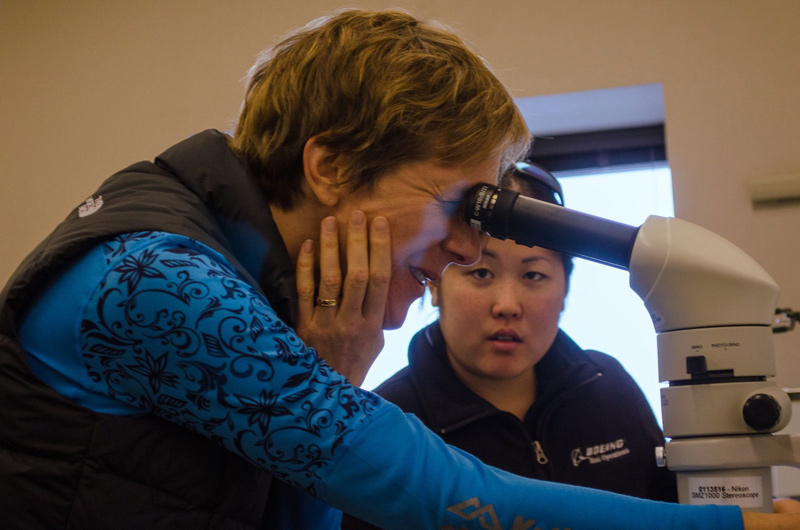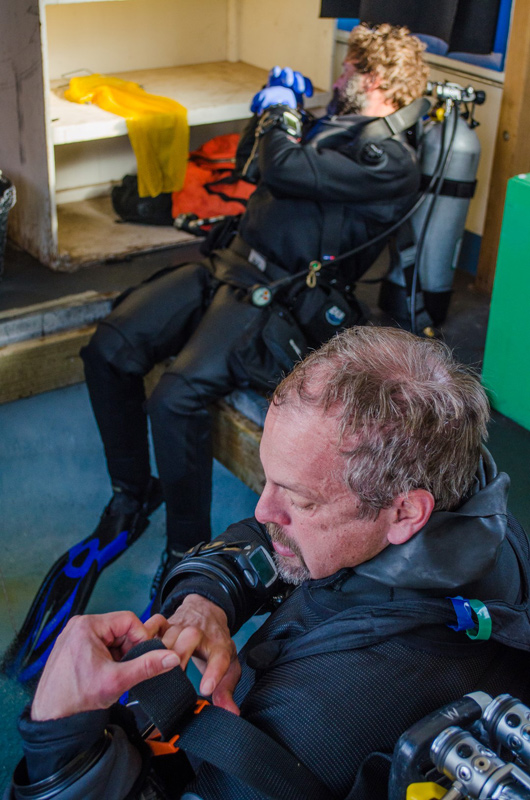
Photo Credit: Bret Tobalske
|
A giant Sea Spider walks along the bottom of McMurdo Sound.
|
Secrets of the Gigantic Sea Spiders
By Michael Lucibella, Antarctic Sun Editor
Posted November 16, 2015
The average sea spider in McMurdo Sound is neither itsy nor bitsy. Although they live in oceans all over the world, to find the really enormous ones, scientists have to trek to Antarctica.
The big scientific question is, why is that the case? And there is no single answer. Yet.

Photo Credit: Michael Lucibella
Amy Moran peers through a microscope at recently hatched sea spiders as Caitlin Shishido looks on.
“We spent a lot of time off the coast of Washington in June of this year looking for sea spiders, and the biggest one we found was about the size of a dime,” said Art Woods, an associate professor of biology at the University of Montana.
But, he continued, it’s not uncommon to find ones as big as dinner plates in the Antarctic.
It’s a phenomenon called “polar gigantism,” and Woods is studying these marine giants as part of a U.S. Antarctic Program-supported team led by Amy Moran at the University of Hawai´i at Mānoa.
The National Science Foundation (NSF) manages the Program, which coordinates all U.S. research on the southernmost continent.
“In general things that live in warmer water and tropical waters tend to be much smaller than the species that live down here,” Woods said. “That’s true across many species of marine organisms.”
Sponges, sea stars, worms and other invertebrates can grow to tremendous sizes in the waters off the coast of Antarctica.
“There are normal-sized ones too, it’s not like something is making everything be big,” Moran said. “It’s like things can be big if they want to.”
She and her team are focusing in on sea spiders, spindly marine creatures that look like a cross between a crab and a daddy-longlegs. Throughout the austral summer season, the team is collecting dozens of specimens of different sizes and species by diving under the ice covering McMurdo Sound.
Several times a week the team makes their way to one of bright orange diving huts set up on the sea ice. After donning extra-insulated layers for their diving suits, strapping on scuba tanks and gathering up their collection nets, they plunge into the icy water below.

Photo Credit: Michael Lucibella
Bret Tobalske (top) and Art Woods (bottom) suit up to collect more sea spider specimens from below the Antarctic Ice.
“It’s really cold,” Steven Lane, a doctoral candidate at the University of Montana, said about diving under the ice. “It’s just crystal clear. It’s awesome. When you go down you can see for hundreds of feet around.”
Below the featureless, barren ice surface, the sea floor is alive. The researchers pass by large sponges, brightly colored sea anemones, fields of sea stars and even the occasional playful seal while looking for their eight-legged quarry.
Back on shore, they’ve prepared a slew of experiments to test these sea spiders’ metabolism, the strength of their legs, how well they can cling to the ocean floor and even their grooming habits.
“They’re very poorly known for a group that’s that important here and has that many species worldwide,” Woods said.
Despite their name, sea spiders are only distantly related to the web-spinners on land. Instead their nearest relatives are horseshoe crabs. They’re known to scientists as pycnogonids, and only picked up the spider moniker because most species have eight legs.
Why these underwater critters grow so big is an open question, one that Moran and her team are diving under the sea ice to investigate.
The prevailing theory is that a combination of plentiful oxygen and cold temperatures lets these organisms grow to sizes that are impossible elsewhere. Atmospheric gases like oxygen dissolve more easily in cold water than in warm water, so the frigid oceans around Antarctica are saturated with the stuff.
“In the water it’s just all oxygen almost everywhere,” Moran said.
"It could be that these animals have no predators here”
Amy Moran, on polar gigantism
Oxygen fuels the chemical reactions that drive a creature’s metabolism by converting food into energy. But in cold polar climates, those reactions slow down and so do the creatures that live there, meaning they use oxygen at lower rates.
“In terms of supply and demand that means that there’s a lot of supply and not very much demand,” Woods said.
However, there could also be other factors. The team is trying to tease out what else in the environment could contribute to these critters’ gigantism.
“It could be that these animals have no predators here,” Moran said. “It could be that they stay small elsewhere because if they get big something eats them, and the fauna here is really different so they may not have predators.”
Currents might also play a role. The only other place outside of the polar oceans where sea spiders grow so large is at the serene bottom of the oceans where currents are slow.
Or it could be some complicated combination of all these factors and more.
“That’s the nightmare that’s almost certainly true,” Woods joked.
Previous
1
2 Next







